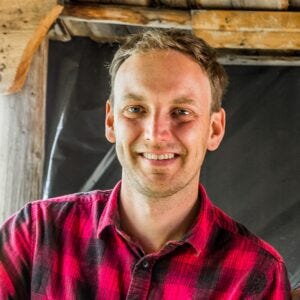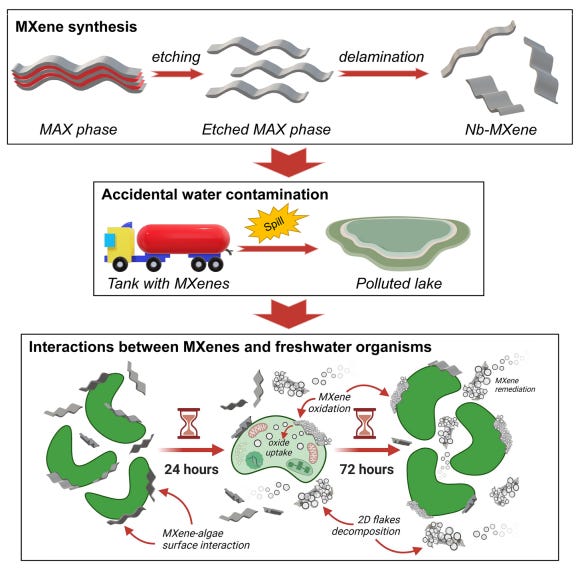🌊Scoping out seaweed challenges and opportunities with Phyconomy
PLUS Vyld seaweed tampon crowdfunding, Penrhos Bio secures £1 million, and how microalgae can deal with nanotech pollution
"Don’t be afraid of breaking into this industry. Everyone’s keen to see new people with a genuine interest in seaweed." — Steven Hermans, Phyconomy
Dear algae technologists - hello and welcome to the Paxtier Report!
Recently, researchers from Saudi Arabia described how Moringa oleifera (L.) leaf extract and green algae (Ulva intestinalis) can be used to improve the salt stress tolerance of Mentha species (Mints).
Essentially, applying MLE and GA to these plants can significantly influence the following pathways:

And here’s what the research team had to say:
Salinisation of the soil due to climate change is causing yield loss worldwide. And salt stress is one of the most important abiotic stresses limiting plant development and productivity, especially in arid and semi-arid regions around the world.
These findings show how MLE and GA can be used to promote field plant development in both normal and salt-stressed environments.
See more HERE.
In today’s report:
Markets: 💸 Vyld is crowdfunding for its seaweed tampon technology
Deals: 🤝Mermade Seafoods is disrupting the $8 billion global scallop market with cell-cultured foods
Research Rundown: 🧪How microalgae can deal with nanotech pollution
Movers and Shakers: 🌊 Seaweed challenges and opportunities with Phyconomy
Around the web: 💡A city powered by seaweed
Markets and Investing
✂️Algae Market Snippets
Some recent big moves:
West Cork seaweed firm secures €1.5m in fresh funding - Pure Ocean Algae is the first commercial end-to-end production platform to produce the red seaweed Palmaria palmata, commonly known as Dulse (Read more HERE).
Allergan Aesthetics announces the launch of SkinMedica Firm & Tone Lotion which contains green microalgae and shitake mushroom extracts. (Read more HERE).
Alternative feed producer Veramis and its partner Empagran, an Ecuadorian shrimp producer, are on course to scoop a $100,000 (€100,721) prize awarded to projects reducing aquaculture’s reliance on forage fish. (Read more HERE).
The US Department of Energy (DOE) has awarded $46 million to 22 projects that will manufacture biofuels to help decarbonize the transportation and power generation sectors. (Read more HERE).
UWO awarded $1.6 million NSF grant for interdisciplinary research on toxic algae. (Read more HERE).
Mermade Seafoods is disrupting the $8 billion global scallop market with cell-cultured foods. And they're growing their cells on biowaste-fed algae via a process called “cytoponics” (Read more HERE).
Green Future Food Hydrocolloid Marine Science begin to produce agar gel microspheres in Fujian, China. The total annual production capacity of agar gel microspheres is 10 tonnes. (Read more HERE).
Vyld is crowdfunding for its seaweed tampon technology. (Read more HERE).
Swiss retailer rolls out ‘coffee balls’ to replace capsules. And the capsules are encased in a thin, flavourless, seaweed-based cover that can be discarded with the coffee after use. (Read more HERE)
The state government has agreed for the expansion of the Aquaculture Industrial Zone (ZIA) for seaweed cultivation at Burst-Point at Sebatik island in Tawau. The island is shared by Malaysia and Indonesia. (Read more HERE).
Acadian Plant Health becomes one of the first biostimulant companies to be approved under the new European Union Product Regulation as part of new Green Deal (Read more HERE).
Penrhos Bio secures £1 million for its disinfectant alternative which is based on red seaweed biology (Read more HERE)
Tanzania seeks multi-billion dollar investments ahead of AGRF 2022 Summit (Read more HERE).
The Alaska Mariculture Cluster, led by Southeast Conference, is among the 21 winners of the $1 billion Build Back Better Regional Challenge. It will support the region’s growing mariculture industry and ensure that it provides shellfish and seaweed for the long-term benefit of Alaska’s economy, environment, and communities. (Read more HERE).
Red seaweed supplement company CH4 Global is moving forward on its path to globalisation after announcing the company’s first integrated EcoPark for sustainable aquaculture in New Zealand. (Read more HERE).
Coastal Farms Australia project off Augusta’s Flinders Bay undergoes last-minute tinkering - A 1ha site south of the Augusta Marina is now proposed for a pilot seaweed project (Read more HERE).
A kelp farming project is among the 14 to be awarded a share of $9.9 million under the latest disbursement of the British Columbia Salmon Restoration and Innovation Fund (BCSRIF). - (Read more HERE).
Sydney Harbour receives $9.1 million funding boost to improve marine habitat and water quality - (Read more HERE).
Demeter Bio-Tech (Zhuhai) Co., Ltd., a microalgae product synthesis enterprise, has recently completed a pre-A round of financing totalling nearly 100 million yuan ($14.50 million) - (Read more HERE).
Singapore-ETH Centre (SEC) and the Bühler Group have announced the deployment of Bühler's Stellar Gemini system at SEC's Urban Microalgae Protein project laboratory in Singapore. The work aims to develop a sustainable, urban single-cell protein production platform. (Read more HERE).
Packaging giant DS Smith explores use of novel seaweed materials as part of their £100 million R&D programme. (Read more HERE).
In depth with Peter Green
🌊Scoping out seaweed challenges and opportunities with Phyconomy
In 2020, Steven Hermans created Phyconomy to track the emerging seaweed economy. Thanks to his insightful newsletter and valuable resources, the site quickly attracted a host of loyal fans. And now, almost two years since its inception, Phyconomy has become a key pillar in the industry.
With that in mind, I wanted to hear Steven’s latest thoughts on the market. So, we set up a quick call. And in this teaser from our recent chat, check out our discussion on major challenges, interesting macroalgae applications, and advice for others in the space.
What major challenges exist for emerging seaweed markets?
Firstly, in Europe and North America we’re seeing considerable market disconnect. Farmers are growing plenty of sugar kelp because it’s easier to farm than species like Palmaria. But a lack of demand makes it hard to sell.
Secondly, we need more startups. While there are plenty of challenges to solve in this space (like high cultivation and processing costs), there just aren’t enough investable opportunities. Investors are calling for more startups with signs of traction and a clear route to market.
At the same time, we need investors to take a long-term perspective. At the end of the day, these are not overnight companies. It’s imperative that investors are patient and let these startups evolve at reasonable speeds.
Where do you see a lot of growth potential?
In general, we’re seeing a lot of growth in feed, food and biostimulants. And I see that trend continuing - especially in seaweed biostimulants as humanity responds to droughts and heatwaves.
Overall, I focus most of my time and resources on these three proven markets. But it’s always great to see people experimenting with innovative seaweed products like bioplastics, dyes, or textiles.
What advice would you give to others in this domain?
I’d like to highlight how welcoming the seaweed world is. When I first came on the scene, I knew very little about macroalgae. But I was very interested in the space and thought I could provide value. And surprisingly, Phyconomy was adopted a lot faster than expected.
In hindsight, it makes a lot of sense – there was a real need for information in this industry and macroalgae folk are generally pretty friendly.
So, in conclusion, don’t be afraid of breaking into this industry. Everyone’s keen to see new people with a genuine interest in seaweed.
If you’d like to learn more about Phyconomy, check out the site, newsletter, and Twitter page. And you can also follow Steven and Phyconomy on LinkedIn .
📝Research Rundown: How microalgae can deal with nanotech pollution
THE BIG IDEA
As various nanotechnologies reach the upscaling stage, there’s a chance they’ll spill into the natural world.
And that’s got environmentalists worried.
But Jakubczak et al. believe they have a solution. And in their recent paper, they detail how Raphidocelis subcapitata can be used to mop up any potential inorganic pollutants.
The breakdown
In this bioremediation study, the researchers used niobium MXenes (Nb-Mxenes) as model 2D nanomaterials and investigated whether microalgae could decompose these products into nontoxic oxides.
In essence, their hypothesis looked something like this:
And it ended up being pretty accurate.
The result
After successfully creating single-layered 2D nanofakes of Nb2CTx and Nb4C3Tx MXenes, the team put the microalgae to the test - and found no severe toxicity of these nanomaterials towards the algae.
What’s more, following prolonged exposure, the little green organisms began to remediate the Nb-Mxenes by oxidising, decomposing and uptaking them (as nontoxic NbO and Nb2O5 oxides).
When reading, be sure to check out…
Their use of the R. subcapitata species - which is one of the best toxicity indicators in nature and a critical participant in food webs. Following these results, it seems this organism could be a key to greener niobium mining and more sustainable nanotechnologies.
🔥 What else was hot in algae tech?
(Paper) Expert perceptions of seaweed farming for sustainable development (Journal of Cleaner Production).
Maritech organic fucoidans named “most innovative ingredient 2022”(Read more HERE).
Autodesk has awarded Pull To Refresh with tools including Inventor, Revit, Maya, AutoCAD and more valued at $151,060. (Read more HERE).
The RaNTrans (Rapid reduction of Nutrients in Transitional Waters) project is using native oysters, seaweed and marine worms to reduce algal mat coverage in the English Channel. - (Read more HERE)
Aquatech startup releases findings from underwater drone test. (Read more HERE).
More research needed to use methane-reducing additives in grazing systems (Read more HERE).
Michoacán biogas firm turns to sargassum as a new source and plans to create a plant in Quintana Roo (Read more HERE). Meanwhile this team is turning sargassum into fertilisers.
IIT Guwahati scientists develop biodegradable, edible coatings that extends the shelf life of fruits and vegetables. The IIT Guwahati team used a mix of micro-algae extract and polysaccharides (Read more HERE).
A University of British Columbia researcher is sending samples of yeast and algae into deep space onboard a NASA spacecraft, in hopes of identifying the genes that allow organisms to survive there. (Read more HERE).
Super nutritious ‘enriched seaweed’ that can help ease global food crisis unveiled by scientists (Read more HERE).
ParAqua develops an interactive database to fill the gap in knowledge about zoosporic parasites (Read more HERE).
Andalucía's fishing sector seeks financial aid due to loss of income and damage caused by invasive algae (Read more HERE).
A tide of economic opportunity? Seaweed extract may hold potential for skin and healthy aging (Read more HERE).
New Study suggests warmer oceans may limit kelp forests’ ability to store carbon for long periods of time (Read more HERE).
Study shows how to double the antioxidant levels of sea grapes (Read more HERE).
🐦Tweets of the week
That’s all folks!
Thanks again for joining us this week. Hope you have a great day and stay tuned for more algae tech updates soon!
Peter







